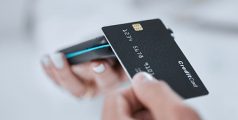
Understanding Credit Card Skimming: Key Facts and Tips to Stay Safe
Posted on Tuesday, March 12th, 2024 | By IndusInd Bank
Imagine swiping your credit card at your favorite café, only to discover later that unauthorized transactions have emptied your account. This unsettling scenario is often the result of credit card skimming—a stealthy method employed by fraudsters to steal your card information during legitimate transactions. As digital transactions become increasingly prevalent, understanding and preventing such threats is crucial.
What is Credit Card Skimming?
Card skimming is a form of digital theft that targets the information stored on your credit card’s magnetic strip. Much like a high-tech pickpocket, card skimmers use covert devices, known as skimmers, to copy the sensitive data from your card when you make a seemingly routine transaction. These devices are often discreetly placed on legitimate card readers, such as gas pumps, or POS terminals, making them difficult to detect.
Once your card information is skimmed, you may not know what kind of financial threats you would face from cybercriminals. Here, the magnetic stripe, which contains your card number, name, and expiration date, becomes the key to access your funds.
What Happens After Your Data is Stolen Through Credit Card Skimming?
Once your card information is compromised, several risks emerge:
● Identity theft
Cybercriminals, once armed with your card number, expiration date, and full name, can lead to identity theft. They may open fraudulent accounts, apply for loans, or engage in other activities that can severely impact your credit score and financial reputation.
● Unauthorised transactions
The stolen data also enables criminals to make unauthorised transactions, such as online shopping, cash withdrawals, etc. on your behalf. These transactions can deplete your funds and leave you grappling with the aftermath.
● Counterfeit card creation
Skimmers can also use the card information to create counterfeit credit cards. These fake cards can be used for in-person transactions, which can further complicate the process of tracking down the perpetrators.
Common Places Where Credit Card Skimming Takes Place
Skimming devices are often installed in locations where card usage is routine:
- ATMs: Especially those in secluded or poorly lit areas.
- Petrol Pumps: Fuel pumps are common targets due to less frequent monitoring.
- Retail Stores: Point-of-sale terminals can be tampered with, particularly in self-checkout lanes.
- Restaurants: Handheld payment devices can be manipulated to skim card data.
How to Spot a Credit Card Skimmer
Here are some tips to help you identify and avoid falling victim to these hidden devices:
- Before inserting your credit card, give the card reader a quick visual check. If anything looks unusual, such as loose parts, mismatched colours, or an ill-fitting card slot, it could be a sign of a skimmer.
- Skimmers are often attached externally and may not blend with the machine. Look for any signs of tampering and check if anything seems out of place.
- If the card reader feels loose, it could indicate the presence of a skimmer.
Steps You Should Take If Your Credit Card is Skimmed
Discovering that your credit card has been skimmed can be unsettling. However, taking corrective actions quickly can minimise the impact. Here’s what you should do:
- Report the incident to the bank or credit card issuer immediately.
- If you’ve confirmed unauthorised activity, request to freeze or cancel your compromised card to prevent further unauthorised transactions.
- If you suspect that your PIN may have been compromised, change it immediately.
- Scrutinise your credit card statements for any transactions that you didn’t authorise. Report these discrepancies to your bank promptly.
Summing Up
Credit card skimming is a covert threat that can have significant financial repercussions. By staying informed and vigilant, you can protect yourself from such fraudulent activities. Regularly inspect card readers, monitor your account activity, and report any suspicious incidents promptly. Remember, proactive measures are your best defense against credit card skimming.



 Offers
Offers Rates
Rates Debit Card Related
Debit Card Related Credit Card Related
Credit Card Related Manage Mandate(s)
Manage Mandate(s) Get Mini Statement
Get Mini Statement
 categories
categories Bloggers
Bloggers Blog collection
Blog collection Press Release
Press Release


